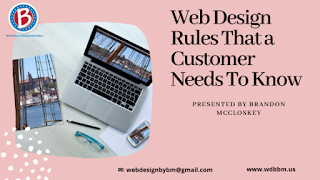Web Design Rules That a Customer Needs To Know
What is a modern website? Easy navigation, beautiful pictures,
graphics and videos, and... many other options that obey certain rules. Today
we’ll talk about the basic rules of web design that are relevant now. Check if
your site matches them!
We’ll make a reservation right away: today we’ll tell you
about the basic rules, a sort of bible of every web designer. There are more
subtle nuances - they will be discussed in the following articles. By the way,
if you come across a specialist who claims that he does not recognize any rules
and loves to be creative, think a hundred times, and even better, look at his
portfolio and evaluate the work personally. Imagine that you came across a
bricklayer who rejects building codes and puts bricks at random - do you trust
him with your house? That's just the same. So, the 13 main rules of good Web design
& development are in front of you.
The Basic
Rules of Web Design
1. Good
page loading speed.
If you have a very good website with all the attractive
graphics, but if your website speed is low then it is really not worth in
spending money on it. Many website designers and experts are so keen on graphic
experiments and they do not pay attention on speed. If you stuff the site with
widgets, animations and videos will slow down your website, not every visitor
will have the patience to wait and they will leave your site.
Think about what matters to you: visualization or speed. We
advise you to look for a middle ground: graphics, of course, are needed, but
ask the web designer to act without fanaticism. Well, make a website on a good
engine: a lot depends on it too.
2. Usability, or usability of the site:
Your site might be the best and attractive, but what is the
use of it if is hopeless. Usability refers to the convenience of a resource for
a visitor. It will make your website user friendly let people spend more time.
It is said that, if the site has a three-click rule - great.
3. Readable
Fonts
The era has long passed, when the more intricate the fonts
were, the steeper it was thought. It happened that the letters were so
intricate that the words simply could not be read. And standard fonts were
superimposed effects and colors. Now the trends have changed: the simpler the
fonts, the better. See how large companies and online stores design sites: they
use large, readable fonts that even a baby can make out. Another rule: on the
page should be no more than 2-3 different fonts. If more - it borders on
foolishness and bad taste. It is permissible to use one font in the logo, the
offer in the second, and the third in the text, and enough.
It is even better to develop a corporate identity, which
will include a certain set of corporate fonts. As a rule, when developing, the
customer is given a brand book in which these fonts are registered. It is very
convenient for further work with designers, a printing house that will produce
business cards, booklets and other promotional materials for you. According to
the terms of the contract, they will be required to use only these fonts in
their work - without any initiative. Subsequently, if you change the web
designer, just give the brand book to another artist - he will understand
everything.
4. Moderate color palette
Here, the rule also applies: no more than 3 colors per page.
Shades and midtones are allowed, but no more. Black, red, yellow and green -
this is already too much: take pity on the poor visitor. Behind a riot of
colors, he simply will not notice useful information or will wade through your
traffic lights with a magnifying glass in his hands. And again we will advise
the corporate identity: in addition to fonts, you will also choose corporate
colors, which you will use in the future for any promotional materials,
including website design, public on social networks, YouTube channel and
others.
5. Modern
background
Another greetings from the nineties: a sophisticated
background, or background, for the site. It is still used among beginner web
designers, on budget websites of second and third level domains, and is very
active in LiveJournal. It is naive to think that if you sell jewelry, gold
placers should go in the background, if products are piles of food. All this is
too obvious and banal. No, the pictures in the subject are always relevant, but
for the background it is better to choose something unusual, unbroken. Pure
tones and gradients, three-dimensional images, virtual reality - that's what is
fashionable now.
6. Unified
Style
The fonts are strict, the colors are cheerful, and the
pictures are pulled from different stocks on the principle “let it be, but
more”? One order form is horizontal, the other is vertical, and each one has
different fonts? Stop, it won’t work: selling design assumes the unity of
style. As the classic said, “you cannot harness a horse and a trembling doe in
one cart!”
7. Golden
Ratio
This is the alpha and omega of any design - the golden ratio
rule gives ideal proportions, the design looks harmonious and natural




Comments
Post a Comment